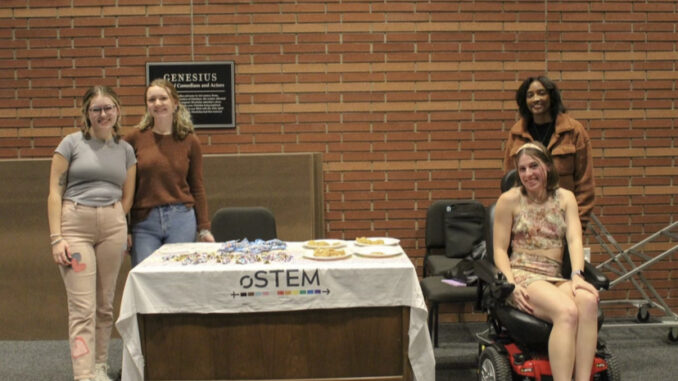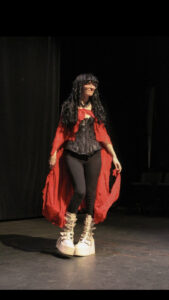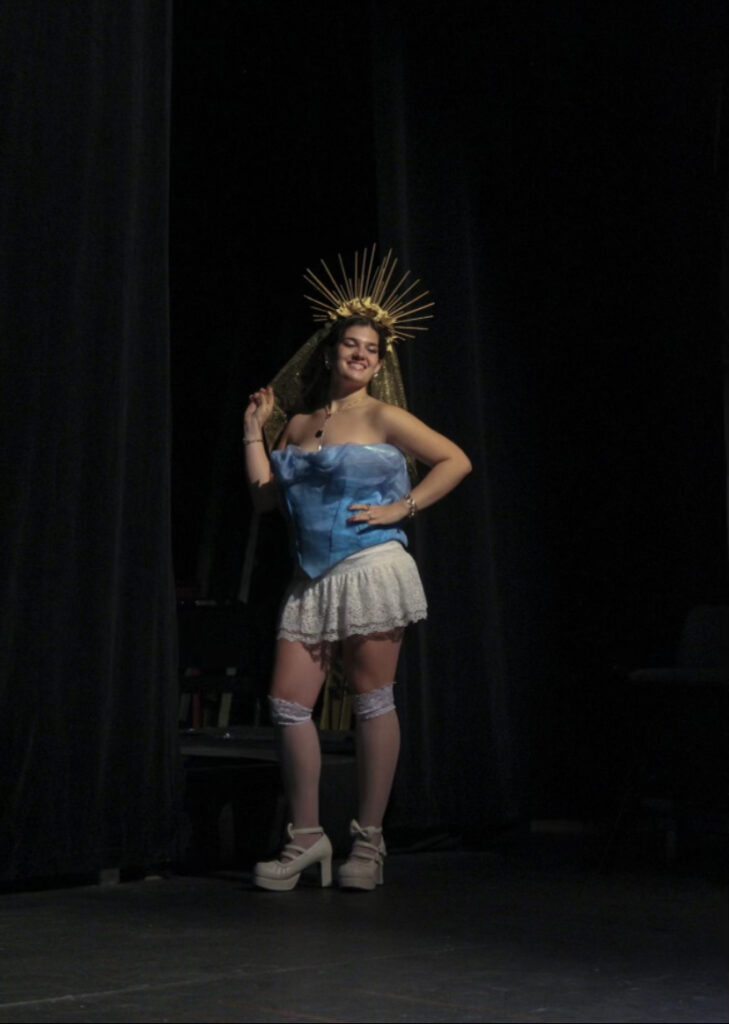
Isabella Abbott | Features Editor
Cinderella corsets, tablecloths and cassettes walked the runway last Friday at the oSTEM club’s first ever Upcycled Fashion Show.
The event featured 10 models wearing upcycled clothing pieces designed by oSTEM members.
Each model strutted out from behind a curtain across the Genesius stage and was introduced with their name and the details of their outfits.
The oSTEM (Out in Science, Technology, Engineering and Mathematics) club is new to Duquesne and aims to create community and opportunity for LGBTQ+ students in STEM.
Vice president Alanna Battle said the new club is great for queer students in science fields.
“I think it’s very important to continuously make room for queer identities especially in STEM spaces,” Battle said.
President Madison Fitzgerald said the show was a good way to bring awareness to the new club on campus as well.
“We didn’t really have anything, especially within the school of science, for anyone in the queer community, which is problematic,” Fitzgerald said.
An avid upcycler since high school Fitzgerald knew it was a necessity for the natural environment.
“Upcycling is important because it keeps a lot of clothing and textile waste out of landfills,” Fitzgerald said.
Upcycling includes reusing clothes and other materials and creating something new with them. Fitzgerald sews old materials to to fix old pieces or make new-looking ones.
An example of upcycling at the event was from pink pants that communications director Megan Mitchell was wearing. Fitzgerald designed Mitchell’s pants after a hole was found, which she patched up with heart patches, making the pants wearable while keeping them fashionable.
Fitzgerald’s own outfit was made from an old table runner, which she made into a headband and a two-piece outfit. She also carried a purse made out of cassette tapes held together with zip ties.
The show started with a speech from Battle, who discussed the effects of textile waste.
“With the introduction of fast fashion, there have been over 92 million tons of textile waste that have been produced each year,” Battle said.
“This is the equivalent to one whole garbage truck of clothes every single second, so it’s important to remember that the most sustainable and affordable clothing that we can have is the clothing that we already own.”
Battle brought up some helpful, cheap alternatives to popular fast fashion brands, like clothing swaps, to get newer or different clothes without as much waste.
One of the models and the designer of three upcycled outfits from the night, Taylor Hufnagel, said upcycling was a way to save money and reuse clothing they already owned.
Hufnagel upcycled old costumes they made in high school and treated these costumes as a way to see the growth in previous designs.
And as a way to save money instead of buying expensive costumes.
“What I would have made in high school, my skills have improved a lot so I took the pieces that I had used before and use them as a kind of knowledge to see how much I’ve grown,” Hufnagel said. “Upcycling really helps you see your skills over time.”
Hufnagel is a grad student at Duquesne but was a member of the oSTEM club at Penn State when they were a student there.
They said Duquesne’s club is more “science-themed fun” rather than only science-focused.
The three Hufnagel designs for the night included different colored corsets that they had owned in high school. One of the outfits they used was from a competition they were in 10 years ago.
Hufnagel was able to save the light blue Cinderella-style dress by cutting off the sleeves and the skirt and making it into a corset.
Someone who wore one of Taylor’s outfits, Ashley Banks, said the event was a fun way to get involved with others. Her upcycled ensembles were comprised of one of Hufnagel’s old blue and purple waist-length wigs, along with a flowy black skirt and long-sleeved top.
Hufnagel’s own outfit was a long red cape paired with white high heeled boots, a black corset and black curly wig. Some other notable pieces of the night were a green cape, a fur coat, a gold crown and many statement jewelry pieces.
“It was nice getting to know other people in the STEM field,” Banks said.
“A lot of times people think that science majors aren’t very artistic, but I love art in general I love making things for people, it’s a way to show people you care to do something differently.”



